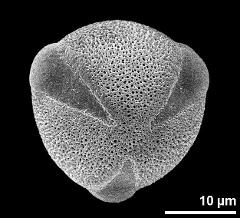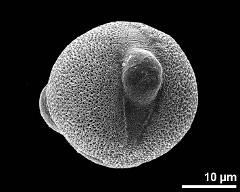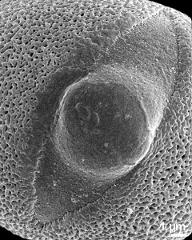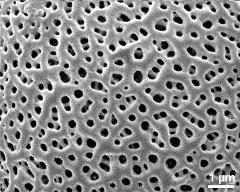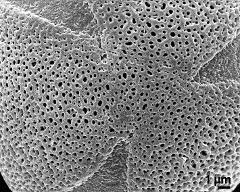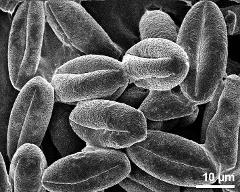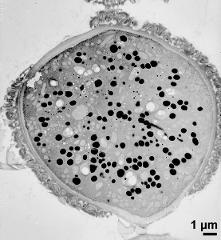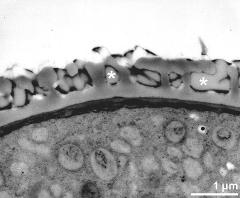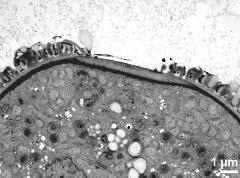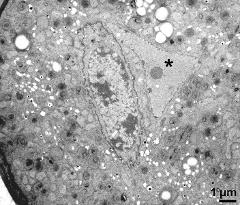Digitalis lutea
Taxonomy: Spermatophyta, Scrophulariales, Veronicaceae, Digitalis
Published: 2005-06-01
Pollen Description
Shape, Size and Aperture
pollen unit: monad, dispersal unit and peculiarities: monad, size (pollen unit): small (10-25 µm), size of hydrated pollen (LM): -, shortest polar axis in equatorial view (LM): -, longest polar axis in equatorial view (LM): -, shortest diameter in equatorial or polar view (LM): -, longest diameter in equatorial or polar view (LM): -, pollen class: -, polarity: isopolar, P/E-ratio: -, shape: spheroidal, outline in polar view: circular, dominant orientation (LM): -, P/E-ratio (dry pollen): prolate, shape (dry pollen): -, outline in polar view (dry pollen): lobate, infoldings (dry pollen): aperture(s) sunken, aperture number: 3, aperture type: colporus, aperture condition: colporate, aperture peculiarities: aperture membrane psilate
Ornamentation and Structure
LM ornamentation LM: psilate, nexine: -, sexine: -, SEM ornamentation SEM: microreticulate, suprasculpture SEM: -, TEM tectum: eutectate, infratectum: columellate, foot layer: continuous, endexine: compact-continuous, intine: monolayered, wall peculiarities: -, supratectal element: -
Miscellaneous
pollen coatings: pollenkitt, reserves in cytoplasm: lipids, cell number: 2-celled, Ubisch bodies: present
Author(s) of diagnosis: Halbritter, H.; Svojtka, M.; Weber, M.
Pictures
Picture legend
- polar view - fresh, rehydrated (water) & critical point dried & sputter coated with gold, photographer: Halbritter, H.
- equatorial view - fresh, rehydrated (water) & critical point dried & sputter coated with gold, photographer: Halbritter, H.
- aperture - fresh, rehydrated (water) & critical point dried & sputter coated with gold, photographer: Halbritter, H.
- exine surface - fresh, rehydrated (water) & critical point dried & sputter coated with gold, photographer: Halbritter, H.
- polar area - fresh, rehydrated (water) & critical point dried & sputter coated with gold, photographer: Halbritter, H.
- dry pollen grains - dry, sputter coated with gold, photographer: Halbritter, H.
- cross section of pollen grain - fresh, glutaraldehyde & osmium & potassium ferrocyanide, uranyl acetate & lead citrate, photographer: Svojtka, M.
- pollen wall; infratectum filled with pollenkitt (asterisks) - fresh, glutaraldehyde & osmium & potassium ferrocyanide, uranyl acetate & lead citrate, photographer: Weber, M.
- aperture - fresh, glutaraldehyde & osmium & potassium ferrocyanide, uranyl acetate & lead citrate, photographer: Weber, M.
- vegetative nucleus (asterisk) and generative cell - fresh, glutaraldehyde & osmium & potassium ferrocyanide, uranyl acetate & lead citrate, photographer: Weber, M.
Literature
- (1961) Vegetation and environment in Denmark in the Early Weichselian Glacial (Last Glacial). Dan Geol Unders II: 175 pp, 15 pl
- (1984) A practical pollen guide to the British flora. Quaternary Res Bull Technical Guide I: 1-139
- (1929) Die Pollenformen als Mittel zur Honigherkunftbestimmung. Bücherei für Bienenkunde. Karl Wachholtz Verlag, Neumünster in Holstein X: 1-116, 23 pl
- (1994) Humidity stress responses in pollen of anemophilous and entomophilous species. Grana 33: 146-150
- (1986) Claves para la determinación de los polenes de las principales especies melíferas de la Península Ibérica. Orsis 2: 27-54
- (1892) Recherches morphologiques et chimiques sur les grains de pollen. La Cellule 8: 47-80
- (1898) A travers les pollens indigènes. Bull Soc Hist Nat Autun 11: 217-238
- (1897) Beiträge zur Biologie und Morphologie des Pollens. Sitzber Böhm Ges Wiss Prag Jahrb XXIII: 1-76
- (1842) Observations on the structure of the pollen granule, considered principally in reference to its eligibility as a means of classification. Ann Mag Nat Hist 8 & 9: 92-108, 544-573
- (1970) Pollen grains of Formosan plants. VI. Taiwania 15: 73-179
- (1956) Pollen grains of Japan. Hirokawa Publishing Co, Tokyo I-XII: 1-304
- (1977) The pollen morphology of plants in Ankara region IV. Scrophulariaceae. Commun Fac Sci Univ Ankara Ser C2 Bot 21: 131-143
- (1989) Palynological studies in the family Scrophulariaceae from Jordan and Iraq. Pollen et Spores 31: 203-214
- (1979) A factor analysis study of the functional significance of Angiosperm pollen. Syst Bot 3: 1-19
- (1981) Aportaciones al estudio de la flora de Andalucia Oriental: Provincia de Jaen (Espana). Bol Soc Bot Ser 2 53: 1013-1036
- (1989) Pollen morphology of the Orobanchaceae and rhinanthoid Scrophulariaceae. Grana 28: 1-18
- (1981) Morphologie du pollen et embryogenése chez Digitalis purpurea L. et D. thapsi L. Rev Roum Biol, Biol Vég 26: 117-122
- (1834) Über den Bau und die Formen der Pollenkörner. Beiträge zur Anatomie und Physiologie der Gewächse. Erstes Heft. Bern 4: 130 pp, 6 pl
- (1835) Sur la structure et les formes des graines de pollen. Ann Sci Nat, Ser 2 3: 148-180, 220-236, 304-346
- (1965) Pollen grains of Western Himalayan Plants. Asia Monographs, India 1 VIII: 1-102
- (1957) Studies in the morphology of pollen grains. Tubiflorae. Phyton 8: 21-42
- (1939) Die Pollenkörner der in Deutschland wild wachsenden Scrophulariaceen. Ber Deutsch Bot Ges 57: 108-121
- (1986) Kartoteka Palynologiczna Roslin Polskich. Opolskie Towarzystwo Przyjaciol Nauk, Zeszyty Przyrodnicze 24: 287-296
- (1973) Palynomorphs of Japanese plants. Spec Publ Osaka Mus Nat Hist 5: 1-60
- (1938) Sur le pollen de l'hybride de Digitalis lutea L. X Digitalis purpurea L. Bull Soc Bot France 85: 584-586
- (1949) Illustration of pollen grains of some Chinese plants. Bot Not 4: 277-282
- (1968) Studies in the family Scrophulariaceae - II. J Palynol Lucknow 4: 91-97
- (1995) Atlas palinológico de la flora vascular del páramo. I. Las familias mas ricas en especies. Caldasia 17: 509-568
- (1989) Pollen morphology of Wightia and ist taxonomic significance. Acta Bot Yunn 11: 65-70
Copyright and Citation
Cite this publication as:
Halbritter H., Svojtka M., Weber M. 2005. Digitalis lutea. In: PalDat - A palynological database. https://pc8.botanik.univie.ac.at/pub/Digitalis_lutea/113233;jsessionid=8F6E000211F7C55BF57BF11BF5CD27F3; accessed 2025-09-16

